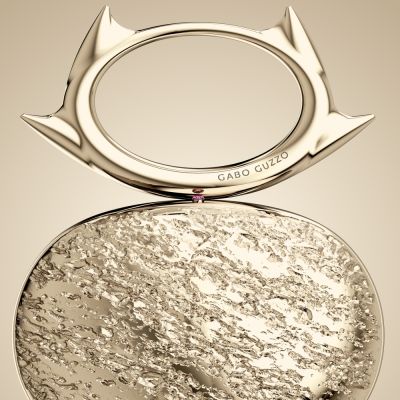Universal Legacy: Budi Tek

Asian contemporary art collector Budi Tek is a committed man on a mission to inspire and preserve a legacy.

Budi Tek is one of the most influential Asian contemporary collectors of our time. With a passion to build public appreciation for contemporary art, the Chinese-Indonesian entrepreneur, art collector, advocate and philanthropist established the Yuz Foundation in 2007, a non-profit organisation dedicated to the promotion of contemporary artists, followed closely by the opening of Yuz Art Museum in Jakarta.
In 2014 he opened the Shanghai Yuz Museum, a private museum that was once the hangar of Longhua Airport. With 9,000 square metres of space, it brought the concept of large-scale installation to China for the first time.
His collection includes global stars from Ai Weiwei, Zhang Xiaogang and Fang Lijun, to Maurizio Cattelan, Fred Sandback and Adel Abdessemed, along with emerging artists.
Beneath the high profile is a committed man on a mission to inspire and preserve a legacy. “Art is lasting, art is patient, art is a gift. It is a gift of faith, hope, and love to the artistic life.” Billionaire speaks exclusively with Budi Tek.
Why and how did you start collecting?
Budi Tek: Collecting is my hobby. Some 20 years ago I started collecting various forms of art, not necessarily contemporary art, but decorative, Balinese and so on. Back then it was just a hobby. Ten years ago, I realised I had fallen in love with contemporary art and established a foundation to collect systematically.
In the beginning, you collect through recommendations and make a lot of mistakes. But I’m a fast learner. With art, if you’re hard working and ready to study by listening to critics, scholars, curators, directors of museums, you start to understand it. Credible galleries can save you a lot of time too, for they have been following and helping artists for many years.
What do you look for in the works you collect?
Collecting is a strategy and you need a plan. I’ve collected historical works of Chinese contemporary art from the early 1980s to the late 1990s, and timing has allowed me the chance. Why? Well there weren’t credible museums systemically chronicling the history of Chinese contemporary art in China. Now, however, many institutions are starting to collect. So, in a sense, the important bodies of historical works will become rarer and rarer to buy. I don’t know how long I can collect these big works at a reasonable price.
Do the international auction houses and movements in the art market affect you?
I don’t follow the auctions much. We aren’t doing ‘serious’ museum work such as buying US$170 million Old Masters. But, one day, you will see serious prices in the auction houses for Chinese contemporary art. Maybe not in my lifetime, but my children are very young so potentially in theirs. And when they enjoy that moment, I’d like to make sure that the foundation that they own is there. It’s no longer personal wealth, it’s not ‘Budi Tek’s’ collection. It’s the Yuz collection, which I share with my family and the world.
I want to make sure my children have no temptation to sell the works. It’s the legacy of me and my family. The future generations will eventually inherit the collection some 100 years later, and it will give them power and respect from society. Maybe it’s a Chinese thing to always think of offspring, but I want my children’s children to be respected, not by the money they inherit, but by the legacy they continue.
What are your most recent purchases?
Yayoi Kusama really touches me. Eighty-something years old and she can still create something so powerful and appealing to the people. Her old works are beautiful and the best have valuations high in the millions now, but I’m more interested in her recent pieces, such as Infinity Room, because I like difficult works.
How an artwork is installed very much influences the perception and the meaning of a piece. Do you study space design and architecture as much as you do art?
Yes. My new project, Budi Desa, [meaning ‘Budi Village’, a large art-filled village just north of Denpasar, Bali] due for completion in two to three years, is all about environment and art. The architecture is specially designed to showcase mega-size artworks. For example, The Rain Room [a large-scale environment installation of perpetually falling water that ceases to pour wherever a person walks] will eventually find its way into Budi Desa after travelling all over Asia. For its permanent installation, the architect [Random International], has designed a dome that will be covered by plants that blend with the surrounding rainforest. The overall theme of the work will be expressed fully through the organic quality of the natural exterior. This is a way architecture can complete an artwork.
During the night, Budi Desa will be a video park. Everything will be video – trees, waterfall, lakes. Bali’s tropical weather means the sun always sets at 6pm, so it is the perfect climate to have a video park and it will be the first in the world.
What projects do you have coming up before the completion of Budi Desa?
We will have an upcoming Giacometti show in March 2016. It will bring to Shanghai more than 250 works, making it the largest retrospective ever shown in Asia. It involves the Chinese and French government in the promotion of cultural exchange. A lot of never-before-seen works will be shown, and I’m happy my museum in Shanghai can do this not only for Asia but for the world.
This article originally appeared in Billionaire's June 2016 Issue, the Time Issue. To subscribe contact








